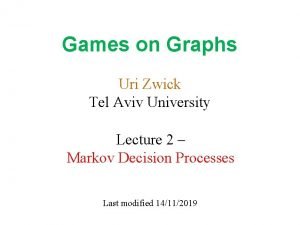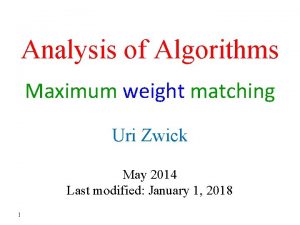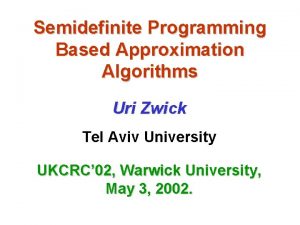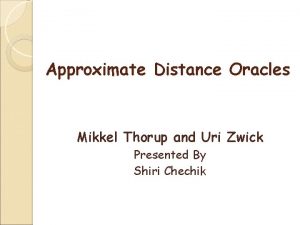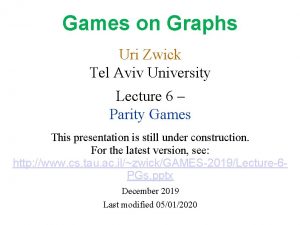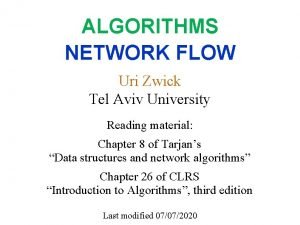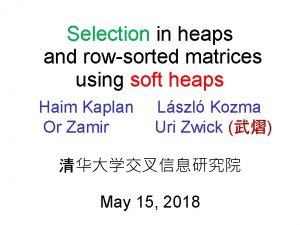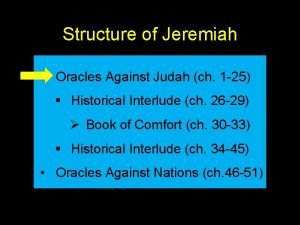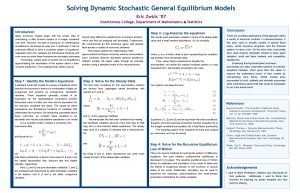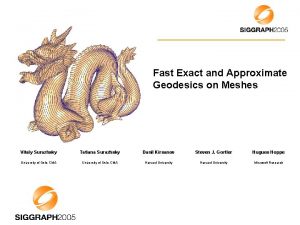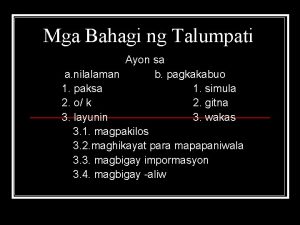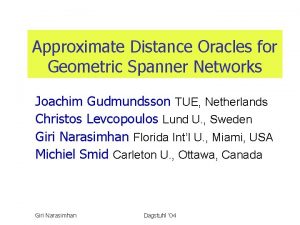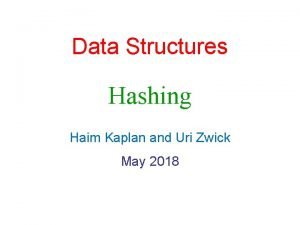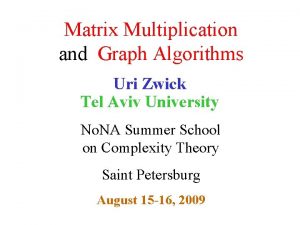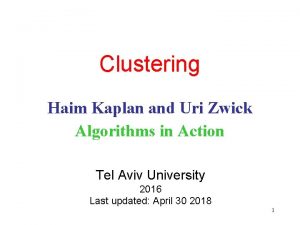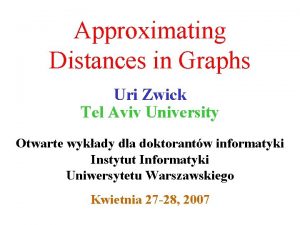Approximate Distance Oracles Mikkel Thorup and Uri Zwick

















![Distance Oracles Lemma: E[|B(v)|]≤kn 1/k |B(v) Ai| is stochastically dominated by a geometric random Distance Oracles Lemma: E[|B(v)|]≤kn 1/k |B(v) Ai| is stochastically dominated by a geometric random](https://slidetodoc.com/presentation_image/33bd6d7d209871145066faf725f32918/image-18.jpg)








- Slides: 26

Approximate Distance Oracles Mikkel Thorup and Uri Zwick Presented By Shiri Chechik

Approximate Distance Oracles Consider a graph G=(V, E). An approximate distance oracle with a stretch k for the graph G is a data-structure that can answer an approximate distance query for any two vertices with a stretch of at most k. For every u, v in V the data structure returns in “short time” an approximate distance d’ such that: d. G(u, v) d’ k· d. G(u, v).

Approximate Distance Oracles Stretch Query time 64 k kn 1/k 2 k+ kn 1/k 2 k-1 k Space Preproc. time Reference Awerbuch. Berger. Cowen-Peleg ‘ 93 kn 1+1/k kmn 1/k Cohen ‘ 93 Thorup. Constant time!is Zwick ‘ 01 Thisquery tradeoff essentially optimal ! Slide from Uri Zwick

Spanners - Formal Definition Consider a graph G=(V, E) with positive edge weights. A subgraph H is a k-spanner of G if for every u, v in V: d. H(u, v) k·d. G(u, v).

Spanners - Example v

Spanners - Equivalent Definition A subgraph H is a k-spanner of G if for every edge (u, v) in E: d. H(u, v) k· w(u, v). x y

Spanners for General graphs Theorem One can efficiently find a (2 k-1)-spanner with at most n 1+1/k edges.

Spanners for General graphs Girth Conjecture (Erdös and others): There are n-vertex graphs with Ω(n 1+1/k) edges that have girth > 2 k. Known for k=1, 2, 3, 5.

Distance Oracles - Construction Preprocessing Phase First build a hierarchy of centers, A 0, …, Ak A 0 V, Ak Ai sample(Ai-1, n-1/k)

Distance Oracles - Construction Preprocessing Phase A 0 = A 1 = A 2 = Ak =

A hierarchy of centers A 0 V ; Ak ; Ai sample(Ai-1, n-1/k) ; Slide from Uri Zwick

Distance Oracles - Construction Preprocessing Phase Notations pi(v) is the closest node to v in Ai For each w AiAi+1 ◦ C(w) {v| δ(v, w) < δ(v, pi+1(v))}

A 0= A 1= A 2= Clusters w Slide from Uri Zwick

Bunches (inverse clusters) Slide from Uri Zwick

Distance Oracles - Example V P 1(V)

Distance Oracles - Example A 0 = {v 1, v 2, v 3, v 4} A 1 = {v 2, v 3} A 2 = {v 3} A 3 = {} V 3 1 2 V 4 1 1. 5 V 1 C(v 1)= {v 1, v 4}, C(v 4)= {v 4} C(v 2)= {v 2, v 1} C(v 3)= {v 1, v 2, v 3, v 4}

Distance Oracles - Construction Preprocessing Phase Data structures For every v V ◦ p 1(v), …, pk-1(v) and the distance from v to pi(v). ◦ C(v) (hash table) and the distance from v to every u in C(v).
![Distance Oracles Lemma EBvkn 1k Bv Ai is stochastically dominated by a geometric random Distance Oracles Lemma: E[|B(v)|]≤kn 1/k |B(v) Ai| is stochastically dominated by a geometric random](https://slidetodoc.com/presentation_image/33bd6d7d209871145066faf725f32918/image-18.jpg)
Distance Oracles Lemma: E[|B(v)|]≤kn 1/k |B(v) Ai| is stochastically dominated by a geometric random variable with parameter p=n-1/k. Slide from Uri Zwick

Distance Oracles Lemma For every two nodes u and v, there exists a node w such that ◦ u, v C(w) ◦ The distance from u to w and from v to w is at most k·d(u, v)

Distance Oracles - Construction Query Phase

Distance Oracles - Construction Query Phase P 3(v) P 2(u) P 1(v) 2 > u < v <3

Distance Oracles - Example What is δ(v 4, v 1)? Is v 1 C(v 4)? w = p 1 (v 1) = v 2 Is v 4 C(v 2)? w = p 2(v 4) = v 3 Is v 1 C(v 3)? – Yes V 3 1 2 V 4 1 1. 5 V 1 C(v 1)= {v 1, v 4}, C(v 4)= {v 4} C(v 2)= {v 2, v 1} C(v 3)= {v 1, v 2, v 3, v 4}

Distance Oracles - Properties Thorup and Zwick (2005) Consider a node v C(w), every node on a shortest path from v to w also belongs to C(w). x Ai+1 v y w

Distance Oracles - Properties Thorup and Zwick (2005) v belongs to C(pi(v)) for every 0≤ i ≤k-1.

Distance Oracles From each cluster, construct a tree T(w) containing shortest path. v u w

Distance Oracles The union of all these trees is a (2 k-1)-spanner with O(kn 1+1/k) edges.
 Skin picking behandling
Skin picking behandling Tbsgs
Tbsgs Maximum weight matching
Maximum weight matching Max cut
Max cut Uri zwick
Uri zwick Cjkls
Cjkls Anti parallel edges
Anti parallel edges Modernize oracle forms systems
Modernize oracle forms systems Soft heaps of kaplan and zwick uses
Soft heaps of kaplan and zwick uses Speaking the oracles of god
Speaking the oracles of god Oracles ch
Oracles ch Lars mikkel aas
Lars mikkel aas Mikkel holm
Mikkel holm Mikkel christiansen lønn
Mikkel christiansen lønn Eric zwick
Eric zwick Mikkel hemmingsen
Mikkel hemmingsen What is the difference between distance and displacement
What is the difference between distance and displacement Fast exact and approximate geodesics on meshes
Fast exact and approximate geodesics on meshes Bahagi at elemento ng talumpati
Bahagi at elemento ng talumpati Salitang pang uri
Salitang pang uri Ano ang ibig sabihin ng palansak
Ano ang ibig sabihin ng palansak The ratio of input distance to output distance
The ratio of input distance to output distance What are kilobytes
What are kilobytes Approximate computing
Approximate computing Approximate 645 to the nearest hundred
Approximate 645 to the nearest hundred Example of a blank verse poem
Example of a blank verse poem Periods of music
Periods of music

